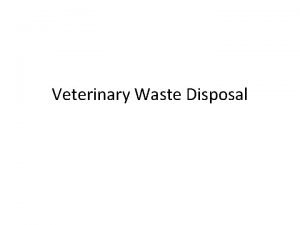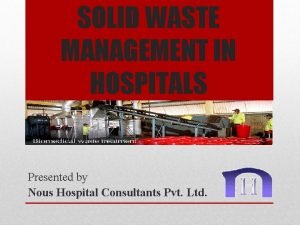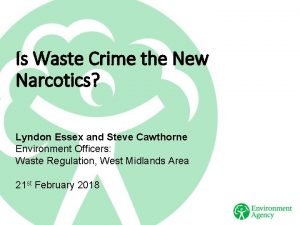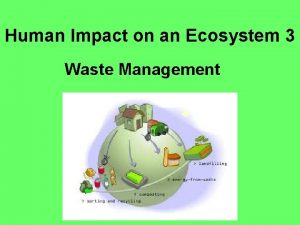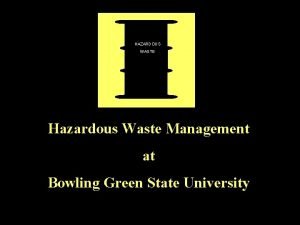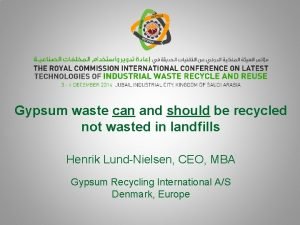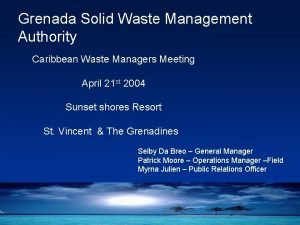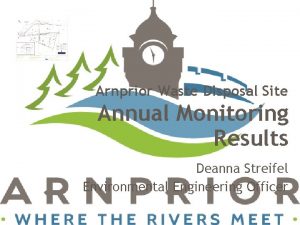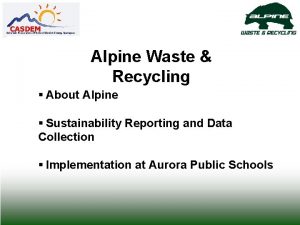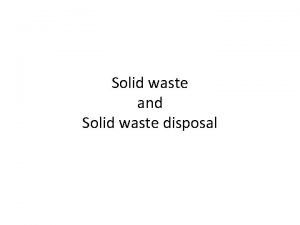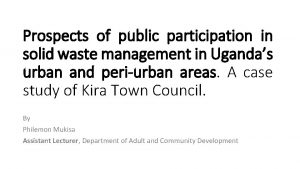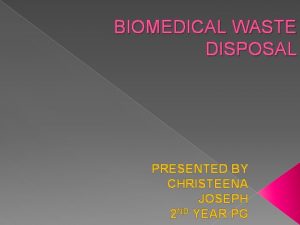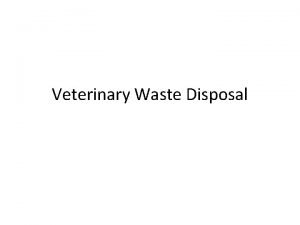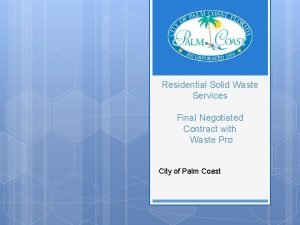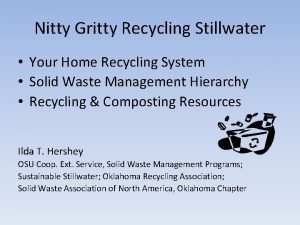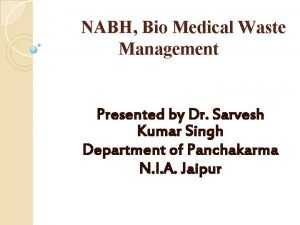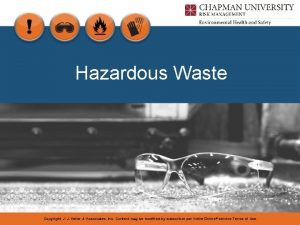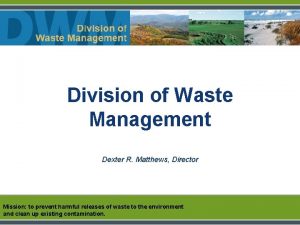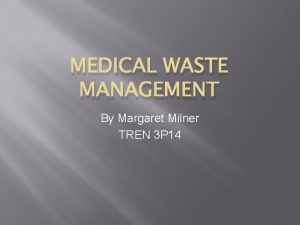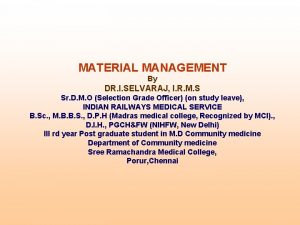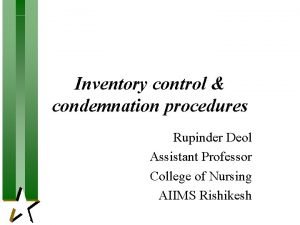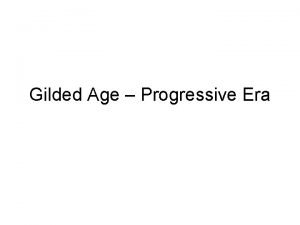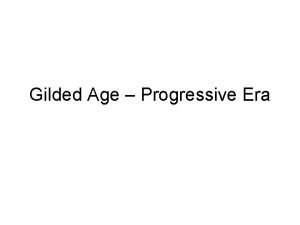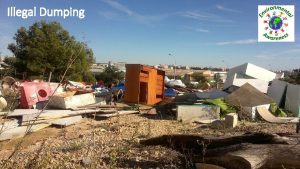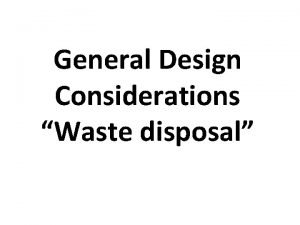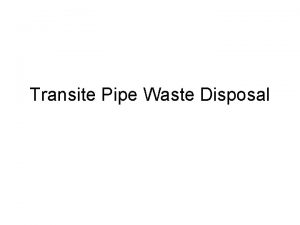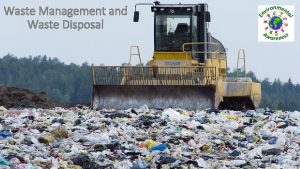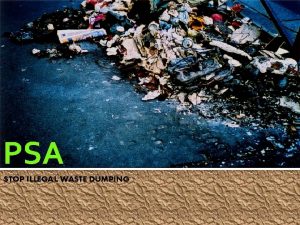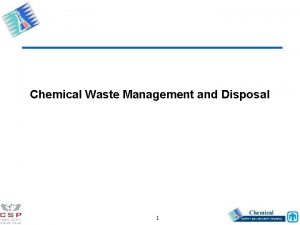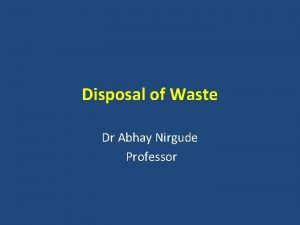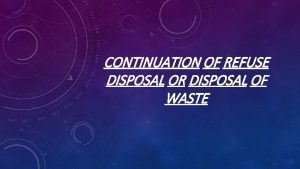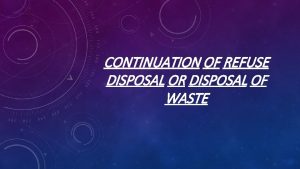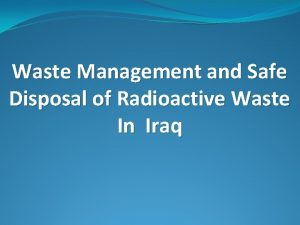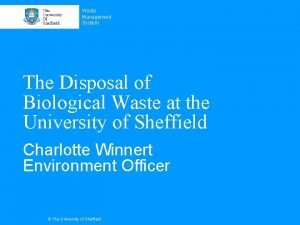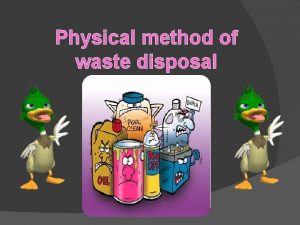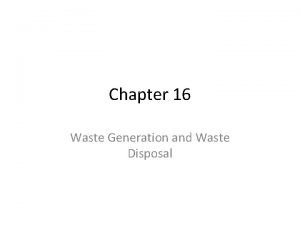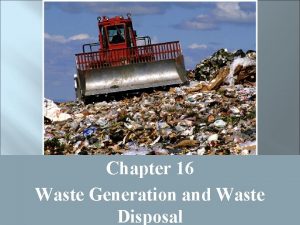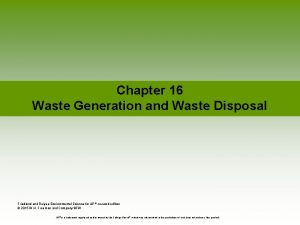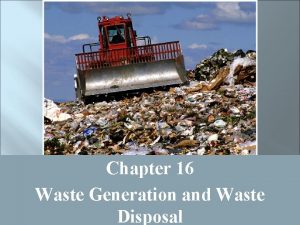Illegal disposal of waste WASTE MANAGEMENT AND TECHNOLOGY






























- Slides: 30

Illegal disposal of waste WASTE MANAGEMENT AND TECHNOLOGY Martin Kubal Institute of Chemical Technology in Prague

Illegal disposal of waste LEGAL ILLEGAL

Case 1: Ostramo lagoons

Case 1: Ostramo lagoons resulted from deposition of the wastes from oil rafinery processes for the time period of about 100 years – until 1996. At the beggining of 21. century the lagoons accumulated about 300 000 tons of higly acidic organic sludges. It was decided to process the organic sludges into the form of alternative fuel. The conversion of organic sludges to alternative fuel consists in: - pumping the sludge from the lagoon to the reaction containers (pits) - Neutralization of sludge by lime (calcium hydroxide) - production of granulated material called as „alternative fuel“ - Providing the final product to the market






Case 1: Ostramo lagoons To which places the alternative fuel was transported: In the Czech Republic - Provisional deposition at the landfill CELIO - Cement plant in Čížkovice (for incineration) In Poland - Provisional deposition of 20 000 tons in the Katowice region (the Polish environmental inspection categorized the material as hazardous waste and asked the Czech Republic to take it back).

Case 2: Illegal depository of municipal waste - 4000 tons of municipal waste from Germany was deposited at the area of the former cow house in Libcice. - The waste was formally owned by a company with limited liability (Ltd), which was going to file for bankruptcy. - The waste deposited in the cow house was burning several times. - Finally part of the waste was returned back to Germany, the remainig part was incinerated.

Case 2: Illegal depository of municipal waste – former cow house in Libcice

Case 3: Illegal depositories of toxic chemical wastes Three localities were identified in the Czech Republic in 2006 - 7 (Libcany, Chvaletice, Nalzovice), in which hazardous chemical wastes were deposited providing extremely high risk towards human health and environment. Incompatible chemical wastes of different origin and properties were stored in mutual contact. Persons without any chemical education or professional background were responsible for distribution of chemicals in the depositories. No evidence or documentation on the chemicals accumulated. All the chemicals stored were available to any person interested and willing to pay for them, police investigation proved chemicals were offered to black market. The buildings, where the chemical wastes were situated, did not satisfy any of technical, fire safety or health standards Chemical time-bomb with unknown point of explosion

Libcany Total amount of 600 tons of hazardous chemicals in the buildings and halls of a former middle size factory in the central part of the village. Chemicals identified - phosgene, radioactive materials, inflammable compounds, self-igniting chemicals in contact with water (sodium), explosive materials, hospital waste

Chvaletice About 200 tons of chemicals, but with significantly higher risks towards human health (many poisonous gases in pressure cylinders). 500 m from the regional thermal power station (800 MW installed power).

Nalzovice 80 tons of chemical waste (broad collection of laboratory chemicals with expired durability with only a minority of unidentified wastes)

Libcany (mixed toxic wastes)

Libcany (hospital waste)

Libcany (drugs)

Libcany (open area)

Libcany (toxic waste hidden beneath municipal waste

Libcany (animal farm in the middle of waste depository)

Case 3: Illegal depositories of toxic chemical wastes After publicity was given to the depositories the purpose-built team was completed for the period of about one year, which consisted of the experts on technical chemistry, toxicology, fire-safety, police investigation and environmental engineering. The team was approved to gradually identified all chemical waste present, dislocate them in the building and transfer to final processing. Fire initiated by chemical reaction was the most probable risk. Especially dangerous were the reactions between volatile organic solvents and oxidizing agents or between alkaline metals and water. If the fire appeared inside any of the three illegal depositories then the time available for effective extinguishment or fire displacement could be estimated for a few seconds. Probably no effective steps could follow later on to stop the fire.

Libcany Separation of wastes according to their chemical properties

Libcany Transport of explosives

Libcany Packaging for incineration

Libcany Metalic sodium

Libcany Metalic sodium

Libcany - risk analysis Demanded by regional fire brigade office the most probable development following after fire initiation was suggested. 1) primary expansion of fire through the floor contaminated with nonvolatile organics; 2) melting-down the plastic tanks with organic wastes and following distribution of fire into the whole building; 3) explosions of volatile organic chemicals followed by fire extension to the neighborhood; 4) fire transfer through the surrounding area.

Libcany - displacement of chemical wastes from illegal depositories - delivering the pressure cylinders to a relevant chemical plant - delivering the explosives to pyrotechnist - offering part of the chemical for their further use (about 10%) - sending chemicals to the incineration plant (almost 90%).
 Waste disposal lindsay
Waste disposal lindsay Disposing of veterinary clinical waste
Disposing of veterinary clinical waste Color coding for waste disposal
Color coding for waste disposal Waste disposal lyndon
Waste disposal lyndon 3 waste disposal
3 waste disposal Biomedical waste management introduction
Biomedical waste management introduction Waste manifest
Waste manifest Disposal of gypsum waste
Disposal of gypsum waste Grenada garbage service
Grenada garbage service Arnprior waste disposal site
Arnprior waste disposal site Alpine waste
Alpine waste Medico waste disposal
Medico waste disposal Bangalore hot fermentation method is a
Bangalore hot fermentation method is a Solid waste disposal introduction
Solid waste disposal introduction Biomedical waste management introduction
Biomedical waste management introduction Veterinary waste
Veterinary waste Definition of waste
Definition of waste Waste pro bunnell
Waste pro bunnell Stillwater ok waste disposal
Stillwater ok waste disposal Nabh checklist for biomedical waste management
Nabh checklist for biomedical waste management Hazardous waste transportation
Hazardous waste transportation Grenada disposal of garbage
Grenada disposal of garbage Matthews waste disposal
Matthews waste disposal Milner waste
Milner waste Condemnation and disposal in material management
Condemnation and disposal in material management Condemnation in material management
Condemnation in material management Plessy v ferguson
Plessy v ferguson What ended reconstruction
What ended reconstruction A mob's illegal seizure and execution of a person.
A mob's illegal seizure and execution of a person. Retention and disposal of gmp documents
Retention and disposal of gmp documents Asset disposal account grade 12
Asset disposal account grade 12

